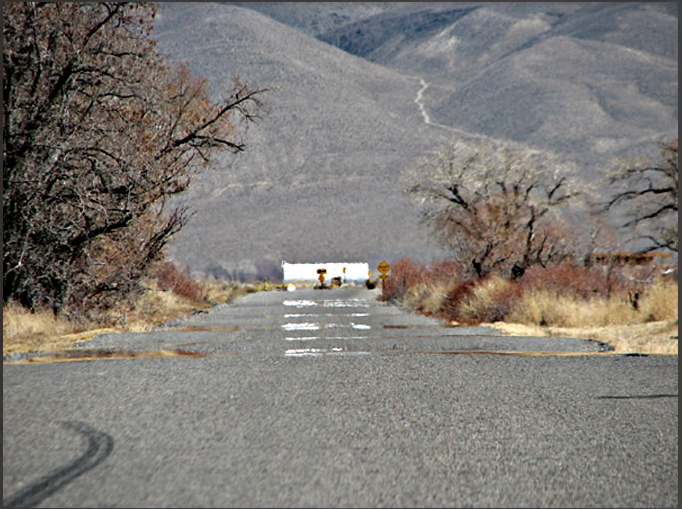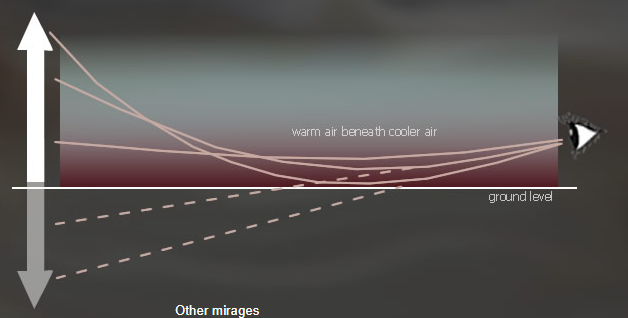Not so humble mirage
Not So Humble Mirage: Exploring the Fascinating World of Atmospheric Optics
Have you ever come across a mirage that left you in awe? One such mirage, known as the road or desert mirage, is a classic and widely recognized atmospheric phenomenon. Often described as humble, this mirage showcases the enchanting illusion of multiple reflections of objects and terrain. Picture a road stretching ahead, seemingly adorned with five or six mirrored images. The undulations in the road surface play a crucial role in creating this mesmerizing spectacle.
The magic of the road mirage unfolds due to the presence of strong temperature gradients in the air layers near the road. As sunlight heats the road surface, it also warms the lower layers of air above it. When light rays from the sky or other objects pass through these varying air layers, they undergo refraction. Refraction causes the rays to curve towards the denser air layer, which, in this case, is the upper colder air. Some rays deviate enough to travel back upwards, creating an illusion of an inverted object below the horizon.
This specific type of mirage is classified as an "inferior mirage," not because it lacks quality or appeal, but because the image appears beneath the actual object. In contrast, "superior mirages" occur when cold air lies beneath warmer air and produce inverted images above the objects. In extreme cases, superior mirages can transform into the legendary Fata Morgana, a complex and captivating optical phenomenon.
To gain a deeper understanding of mirages and their intricacies, exploring Andrew Young's mirage pages with recent simulations is highly recommended. Young's expertise sheds light on the scientific explanations behind these captivating illusions.
As we delve into the captivating world of atmospheric optics, it's important to note that this article has been automatically converted from an older version and may not appear exactly as intended. However, fear not, for we are here to unravel the wonders of the not so humble mirage.
Now that we've grasped the basics, let's take a closer look at the factors that contribute to the formation of this awe-inspiring mirage:
-
Temperature Gradients: Strong temperature variations in the air layers near the road play a pivotal role in creating the road mirage. The heating of the road surface by sunlight causes the lower air layers to warm up, setting the stage for this optical phenomenon.
-
Refraction: As light rays pass through the varying air layers, they undergo refraction, causing them to bend towards the denser air layer. This bending is responsible for the curved trajectory of the rays and their subsequent reflection, resulting in the illusion of multiple mirrored images.
-
Inversion Illusion: Due to the bending of light rays, an inverted image appears below the actual object. This inversion gives rise to the captivating and surreal experience of witnessing objects seemingly reflected beneath the horizon.
The road mirage is just one facet of a vast and intriguing realm known as atmospheric optics. Let's explore some additional fascinating phenomena:
-
Superior Mirages: In contrast to inferior mirages, superior mirages occur when colder air lies beneath warmer air. These mirages produce inverted images above the objects, defying our expectations and offering a glimpse into the mysteries of atmospheric optics.
-
Fata Morgana: A phenomenon that can arise from superior mirages, Fata Morgana is a complex mirage that creates elaborate and distorted images, often resembling castles or cities in the sky. This captivating optical illusion has fascinated observers throughout history.
-
Mirage Simulation: Thanks to advancements in technology, experts like Andrew Young have developed simulations that provide valuable insights into the intricate workings of mirages. These simulations allow us to visualize and comprehend these optical phenomena with greater clarity.
As we marvel at the wonders of atmospheric optics, it's essential to keep in mind that these illusions are products of the natural world. While they may appear magical, they can be explained through the principles of physics and the behavior of light. The study of atmospheric optics not only enriches our understanding of the natural world but also highlights the sheer beauty and complexity that surrounds us.
In conclusion, the road mirage, often described as humble, is a captivating example of atmospheric optics. Its multiple reflections and inverted images create a sense of wonder and intrigue. By exploring the factors that contribute to its formation, such as temperature gradients and refraction, we gain a deeper appreciation for the science behind this optical phenomenon. Additionally, the world of atmospheric optics offers us a myriad of other fascinating phenomena to explore, from superior mirages to the enchanting Fata Morgana. So, next time you encounter a mirage, take a moment to marvel at the wonders of the not so humble mirage and the captivating realm of atmospheric optics.

Multiple Road Mirage imaged by Andrew Kirk on a cold winter day near Bishop, California. �Andrew Kirk, shown with permission.
Andrew describes it as a humble mirage but the road or desert mirage is the classical and best known of all the mirages. Unusually this one shows five or six ‘reflections’ of the white object and terrain. Undulations in the road could be responsible.
The mirage arises from strong temperature gradients in the air layers near the road. Sunlight has heated the road surface and this in turn has heated the lower air layers.
Light rays from the sky or other objects are refracted as they pass through the air layers. The direction of refraction is that rays curve towards the denser air layer – in this case towards the upper colder air. Some rays are sufficiently deflected that they travel back upwards. To the eye these appear to come from an inverted object below the horizon.
This type of mirage is named an ‘inferior mirage’, not for any lack of quality or appeal but because the image is beneath the real object. Superior mirages produced by cold air beneath warmer, have an inverted image above the object. In the extreme the latter develop into the fabled Fata Morgana (1,2,3).
For an expert explanation of mirages see Andrew Young's mirage pages with recent simulations.

Note: this article has been automatically converted from the old site and may not appear as intended. You can find the original article here.
Reference Atmospheric Optics
If you use any of the definitions, information, or data presented on Atmospheric Optics, please copy the link or reference below to properly credit us as the reference source. Thank you!
-
<a href="https://atoptics.co.uk/blog/not-so-humble-mirage/">Not so humble mirage</a>
-
"Not so humble mirage". Atmospheric Optics. Accessed on April 20, 2024. https://atoptics.co.uk/blog/not-so-humble-mirage/.
-
"Not so humble mirage". Atmospheric Optics, https://atoptics.co.uk/blog/not-so-humble-mirage/. Accessed 20 April, 2024
-
Not so humble mirage. Atmospheric Optics. Retrieved from https://atoptics.co.uk/blog/not-so-humble-mirage/.